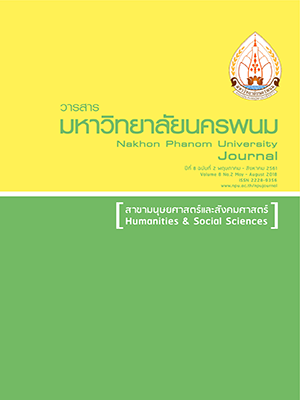ความสัมพันธ์เชิงสาเหตุของปัจจัยที่ส่งผลต่อการมีส่วนร่วมกับโครงการด้านศิลปวัฒนธรรม ของนิสิตมหาวิทยาลัยศรีนครินทรวิโรฒ
Main Article Content
Abstract
The purposes of this study were: 1) to examine the causal relationship of factors affecting the University students’ both direct and indirect participation in arts and cultural projects and 2) to verify whether the hypothesized causal relationship model of factors affecting the University students’ participation in arts and cultural projects has goodness-of-fit with the empirical data. The study is quantitative research. The sample of study selected by cluster random sampling was 300 students who were enrolled at Srinakharinwirot University in academic year 2016. The instrument used was a questionnaire with discrimination power values ranging between 0.45 and 0.91 and Cronbach’s alpha coefficients ranging from .82 to .92. Data analysis was done using descriptive statistics; and a structural equation model analysis of relationships among the factors affecting participation was conducted.
Findings of the study revealed as follows: 1) The developed causal relationship model had goodness-of-fit with the empirical data by gaining the following values: c2 =44.26 df=34 p-value= 0.10 GFI= 0.97 AGFI= 0.96 CFI= 0.98 SRMR= 0.02 RMSEA= 0.05.; 2) the factors that directly affected the University students’ positive participation in arts and cultural projects at the .05 level of significance were those of internal communication, atmosphere within the campus, attitude towards participation and motivation to do activities, respectively. Atmosphere within the campus had positive indirect influence on the University students’ participation at the .01 level of significance via 2 parts: path 1 is a path to participation via attitude, and path 2 is a path to participation via motivation to do activities. The causal factors could jointly explain 49% of variance of the University students’ participation in arts and cultural projects.
Article Details
References
พฤทธิ์ ศุภเศรษฐศิริ. (2556). การพัฒนาสื่อบทเรียนอิเล็คทรอนิกส์ : สุนทรียศาสตร์ร่วมสมัย. วารสารสถาบันวัฒนธรรมและศิลปะ.15(1), 67.
พิสณุ ฟองศรี. (2552). การสร้างและพัฒนาเครื่องมือวิจัย. กรุงเทพฯ : ด่านสุธาการพิมพ์.
พูลพงศ์ สุขสว่าง. (2556). โมเดลสมการโครงการ. กรุงเทพฯ : วัฒนาพาณิชย์.
วลัยทิพย์ เปรมทวีธนโชติ. (2557). การศึกษาลักษณะของการมีส่วนร่วมในกิจกรรมนักศึกษากับคุณลักษณะด้านจิตอาสาของนิสิตนักศึกษา. วารสารวิชาการ Veridian E-Journal ฉบับมนุษยศาสตร์สังคมศาสตร์ และศิลปะ. 7(3), 819-833.
วีรเทพ สุดแดน ภูมิพงศ์ จอมหงษ์พิพัฒน์ และปทุมทิพย์ ม่านโคกสูง. (2556). ยุทธศาสตร์การส่งเสริมการเข้าร่วมกิจกรรมเสริมหลักสูตรของนิสิต. วารสารมหาวิทยาลัยนครพนม. 3(3), 27-32.
ศศิธร สิทธิพรหม. (2559). การรับรู้และการมีส่วนร่วมของนักศึกษาต่อการดำเนินงานการประกันคุณภาพการศึกษา. วารสารมหาวิทยาลัยขอนแก่น (ฉบับบัณฑิตศึกษา) มนุษยศาสตร์และสังคมศาสตร์ มหาวิทยาลัยขอนแก่น. 5(2), 237–258.
ส่วนส่งเสริมและบริการการศึกษา มหาวิทยาลัยศรีนครินทรวิโรฒ. (2560). สถิติการลงทะเบียนนิสิต ปีการศึกษา 2559.สืบค้นเมื่อ มกราคม 2560, จาก https://edservice.oop.swu.ac.th/.
สุรชัย ทุหมัด. (2559). รายงานสรุปผลการดำเนินงานตามพันธกิจสถาบันวัฒนธรรมและศิลปะ มหาวิทยาลัยศรีนครินทรวิโรฒ. เอกสารรายงานประกอบโครงการสัมมนาทบทวนแผนยุทธศาสตร์. กรุงเทพฯ : มหาวิทยาลัยศรีนครินทรวิโรฒ.
เสมอ จุ่นเจริญ. (2557). ปัจจัยที่ส่งผลต่อการมีส่วนร่วมทางการเมืองของประชาชน ในเขตเทศบาลจังหวัดชลบุรี. วารสารวิชาการ มหาวิทยาลัยปทุมธานี. 6(2), 177–183.
สำนักงานเลขาธิการสภาการศึกษา. (2560). กรอบทิศทางแผนการศึกษาแห่งชาติ. สืบค้นเมื่อ มีนาคม 2560, จาก www.krusmart.com/national-education-plan-2560-257/.
อมรเทพ สีนวนสูง. (2559). ความคิดเห็นต่อการเข้าร่วมกิจกรรมนักศึกษาของนักศึกษามหาวิทยาลัยเทคโนโลยีราชมงคลกรุงเทพ. Veridian E-Journal. 9(1), 1,053–1,065.
Astin, A. W. (1984).The Theory of Parcitipatory of Student. Retrived January 2017, from www.gotoknow .com/ posts .
Arthur, W. C & Reiser, L. (1993). Education and Indentity 2ndEd. San Francisco: Jossey-Bass Publishers.
Cohen, J.M. & Uphoff N.T. (1981). Rural Development Participation : Concept and Measures for Project Design Implementationand Evaluation. Rural Development Committee Center for International Studies, Cornell University.
Cummings, T. G., & Worley, C. G. (2008). Organization Development & Change, 9th Ed., Cengage Learning : South-Western Cengage Learning.
Fornaroff, A. (1980). Community Involvement in Health System for Primary Health Care. Geneva: World Health Organization.
Gamson, W.A. (1992). The social psychology of collective action. In A Morris & C. Mueller (Eds.), Frontiers of social movement theory.New Haven: Yale University Press.
Hair, J. F., Jr., Black, W. C., Babin, B. J., Anderson, R. E., & Tatham, R. L.(2010).Multivariate data analysis 6th Ed. Upper Saddle River . New Jersey : Prentice Hall.


